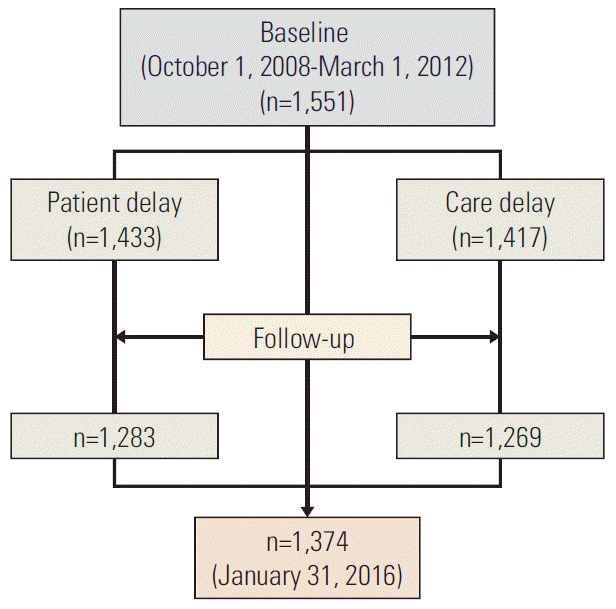1. Caplan L. Delay in breast cancer: implications for stage at diagnosis and survival. Front Public Health. 2014; 2:87.

2. Richards MA, Westcombe AM, Love SB, Littlejohns P, Ramirez AJ. Influence of delay on survival in patients with breast cancer: a systematic review. Lancet. 1999; 353:1119–26.

3. Rabinovich M, Vallejo C, Perez J, Rodriguez R, Cuevas M, Machiavelli M, et al. Impact of delay to treatment upon survival in 1067 patients with breast-cancer. Int J Oncol. 1993; 2:197–201.

4. Arndt V, Sturmer T, Stegmaier C, Ziegler H, Becker A, Brenner H. Provider delay among patients with breast cancer in Germany: a population-based study. J Clin Oncol. 2003; 21:1440–6.

5. Yoo TK, Han W, Moon HG, Kim J, Lee JW, Kim MK, et al. Delay of treatment initiation does not adversely affect survival outcome in breast cancer. Cancer Res Treat. 2016; 48:962–9.

6. Brazda A, Estroff J, Euhus D, Leitch AM, Huth J, Andrews V, et al. Delays in time to treatment and survival impact in breast cancer. Ann Surg Oncol. 2010; 17 Suppl 3:291–6.

7. Mujar M, Dahlui M, Yip CH, Taib NA. Delays in time to primary treatment after a diagnosis of breast cancer: does it impact survival? Prev Med. 2013; 56:222–4.

8. Shin DW, Cho J, Kim SY, Guallar E, Hwang SS, Cho B, et al. Delay to curative surgery greater than 12 weeks is associated with increased mortality in patients with colorectal and breast cancer but not lung or thyroid cancer. Ann Surg Oncol. 2013; 20:2468–76.

9. Yun YH, Kim YA, Min YH, Park S, Won YJ, Kim DY, et al. The influence of hospital volume and surgical treatment delay on long-term survival after cancer surgery. Ann Oncol. 2012; 23:2731–7.

10. Jones SC, Johnson K. Women's awareness of cancer symptoms: a review of the literature. Womens Health (Lond). 2012; 8:579–91.

11. Yu W, Yu X, Hu H, Duan G, Liu Z, Wang Y. Use of hospital appointment registration systems in China: a survey study. Glob J Health Sci. 2013; 5:193–201.

12. Violence against doctors: why China? Why now? What next? Lancet. 2014; 383:1013.
13. Huo Q, Cai C, Zhang Y, Kong X, Jiang L, Ma T, et al. Delay in diagnosis and treatment of symptomatic breast cancer in China. Ann Surg Oncol. 2015; 22:883–8.

14. Neal RD, Allgar VL. Sociodemographic factors and delays in the diagnosis of six cancers: analysis of data from the "National Survey of NHS Patients: Cancer". Br J Cancer. 2005; 92:1971–5.

15. Hansen RP, Olesen F, Sorensen HT, Sokolowski I, Sondergaard J. Socioeconomic patient characteristics predict delay in cancer diagnosis: a Danish cohort study. BMC Health Serv Res. 2008; 8:49.

16. He JR, Tang LY, Yu DD, Su FX, Song EW, Lin Y, et al. Epstein-Barr virus and breast cancer: serological study in a high-incidence area of nasopharyngeal carcinoma. Cancer Lett. 2011; 309:128–36.

17. Ruddy KJ, Gelber S, Tamimi RM, Schapira L, Come SE, Meyer ME, et al. Breast cancer presentation and diagnostic delays in young women. Cancer. 2014; 120:20–5.

18. Arndt V, Sturmer T, Stegmaier C, Ziegler H, Dhom G, Brenner H. Patient delay and stage of diagnosis among breast cancer patients in Germany: a population based study. Br J Cancer. 2002; 86:1034–40.
19. Zheng Y, Wu CX, Zhang ML. The epidemic and characteristics of female breast cancer in China. China Oncol. 2013; 23:561–9.
20. Leon-Rodriguez E, Molina-Calzada C, Rivera-Franco MM, Campos-Castro A. Breast self-exam and patient interval associate with advanced breast cancer and treatment delay in Mexican women. Clin Transl Oncol. 2017; 19:1276–82.

21. Gangane N, Anshu , Manvatkar S, Ng N, Hurtig AK, San Sebastian M. Prevalence and risk factors for patient delay among women with breast cancer in rural India. Asia Pac J Public Health. 2016; 28:72–82.

22. Abu-Helalah AM, Alshraideh HA, Al-Hanaqtah M, Da'na M, Al-Omari A, Mubaidin R. Delay in presentation, diagnosis, and treatment for breast cancer patients in Jordan. Breast J. 2016; 22:213–7.

23. Wall P, Moore C, El-Tamer M, Reilly JJ. Diagnostic delay in breast disease: a system analysis of a public urban hospital. Arch Surg. 1998; 133:662–6.
24. Hershman D, McBride R, Jacobson JS, Lamerato L, Roberts K, Grann VR, et al. Racial disparities in treatment and survival among women with early-stage breast cancer. J Clin Oncol. 2005; 23:6639–46.

25. Gould-Martin K, Paganini-Hill A, Casagrande C, Mack T, Ross RK. Behavioral and biological determinants of surgical stage of breast cancer. Prev Med. 1982; 11:429–40.

26. Afzelius P, Zedeler K, Sommer H, Mouridsen HT, Blichert-Toft M. Patient's and doctor's delay in primary breast cancer: prognostic implications. Acta Oncol. 1994; 33:345–51.

27. Ramirez AJ, Westcombe AM, Burgess CC, Sutton S, Littlejohns P, Richards MA. Factors predicting delayed presentation of symptomatic breast cancer: a systematic review. Lancet. 1999; 353:1127–31.

28. Nosarti C, Crayford T, Roberts JV, Elias E, McKenzie K, David AS. Delay in presentation of symptomatic referrals to a breast clinic: patient and system factors. Br J Cancer. 2000; 82:742–8.

29. Meechan G, Collins J, Petrie KJ. The relationship of symptoms and psychological factors to delay in seeking medical care for breast symptoms. Prev Med. 2003; 36:374–8.

30. Schernhammer ES, Laden F, Speizer FE, Willett WC, Hunter DJ, Kawachi I, et al. Rotating night shifts and risk of breast cancer in women participating in the nurses' health study. J Natl Cancer Inst. 2001; 93:1563–8.

31. Wang Z, Li N, Jiang M, Dear K, Hsieh CR. Records of medical malpractice litigation: a potential indicator of health-care quality in China. Bull World Health Organ. 2017; 95:430–6.

32. Guthrie TH. Breast cancer litigation: an update with practice guidelines. Breast J. 1999; 5:335–9.

33. Mohd Mujar NM, Dahlui M, Emran NA, Abdul Hadi I, Wai YY, Arulanantham S, et al. Complementary and alternative medicine (CAM) use and delays in presentation and diagnosis of breast cancer patients in public hospitals in Malaysia. PLoS One. 2017; 12:e0176394.





 PDF
PDF Citation
Citation Print
Print



 XML Download
XML Download